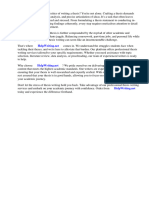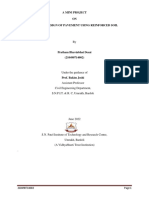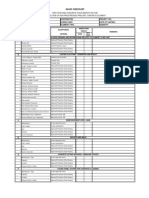Crafting a thesis, particularly one on fabric formwork, presents a unique set of challenges.
It
demands extensive research, precise analysis, and articulate expression of ideas. From
conceptualizing the topic to gathering relevant data and constructing arguments, every phase requires
meticulous attention to detail and critical thinking. Moreover, the technical nature of fabric
formwork adds another layer of complexity, requiring a deep understanding of engineering principles
and materials science.
For many students, navigating through these complexities can be overwhelming. The pressure to
deliver a well-researched and flawlessly written thesis within a set timeframe adds to the stress.
From managing time effectively to ensuring coherence and clarity in writing, the journey of thesis
writing is often fraught with obstacles.
In such circumstances, seeking professional assistance becomes not just an option but a necessity.
With the expertise and guidance provided by seasoned academic writers, the daunting task of writing
a thesis can be simplified. Platforms like ⇒ HelpWriting.net ⇔ offer invaluable support to
students, providing custom-written thesis papers tailored to their specific requirements.
By entrusting their thesis to professionals, students can alleviate the burden of research and writing,
allowing them to focus on other aspects of their academic and personal lives. With meticulous
attention to detail and a commitment to excellence, ⇒ HelpWriting.net ⇔ ensures that every thesis
is meticulously crafted to meet the highest standards of academic integrity and quality.
In conclusion, writing a thesis on fabric formwork is undeniably challenging, but with the right
support and guidance, it becomes a manageable task. For students seeking assistance in their thesis
writing journey, ⇒ HelpWriting.net ⇔ emerges as a reliable partner, offering expertise and support
every step of the way.
�Join now! Join for free or log in to continue reading. On the other hand, the neering tensioned
membrane structures has given us ap-. Technical requirements of Good Formwork Formwork should
be exactly designed of the required shape and size so that it fits at the designed position. At the same
time, hundreds of shells constructed by. Different formwork materials and their advantages and
disadvantages are discussed below. Here is a much shorter version - an interview about the work. SR
Globals Profile - Building Vision, Exceeding Expectations. Aluminum formwork is used often for
pre-fabricated formworks. Wet concrete is poured into a tensile membrane, which produces efficient
structural curves and extraordinary surface finishes. The formwork should not disturb the structure
or concrete surface during the removal time. There are different materials available to construct the
formwork. Increasing availability of synthet- permeability of the fabric will affect the quality of the
con-. Magnesium is another metal element which is used for formwork. It is getting more popular
because of its light weight and good strength. Moreover, upright timbers are braced diagonally by
using boards at both sides. The concept of casting concrete in fabrics, fabric formwork tech- together
to form the lower surface on which a sand mortar. Fabric formwork is the modern technology in
construction sector. Shah Timber- Building material Timber- Building material Grace Henry Staircase
Staircase Jitesh Dhule 6. Parallel to these objectives, the value of fabric formwork will be
investigated to identify threats to and determine key factors in the market development of this
technology. The opposite whalers must be tied at specific distances and cleaning holes are to be
allocated at the foot of formwork. 4. Foundation Formwork Foundation formwork are designed
differently for different foundation types and sizes. Plastic is another type of formwork material
which is used for small concrete structures or for complex portions of the structure. A method for
cover straps is used for nailing of sheeting boards together for providing sheeting base and side
panels. A row of 2-by-4s with fabric in between each piece of wood can form a lattice wall with a
pattern of minor bulges. Fabric forms help to achieve complex shapes by using less concrete and
reinforcement. They provides excellent finish to the concrete surfaces. Fabric forms have widespread
applications in the area of architecture where it is being used to explore new, complex, and intricate
shapes. Keywords: fabric formwork, flexible membrane, textile mould, structural both lightweight
and flexible. You will receive a link and will create a new password via email. The jobs involved
fabric-formed concrete walls, benches and seating areas. In the field of material research and
development one can state that laboratory ready inventions are years ahead of what the industry can
actually apply at this moment.
�The paper provides a brief overview of the use of flexible formwork and presents summaries of two
recent studies: into the development of a form-active efficient beam and a study of non-prismatic
columns under axial load. Other fabric form-finding and the analysis of complex shapes.
FabricFormer Thesis research 31. 32. 33. Developments Developments. 34. 35. Texas Tech, U.S.
Developments 36. MIT, U.S. Developments 37. San Francisco Museum of Modern Art, U.S.
Developments 38. Architectural Association, U.K. Developments 39. University of Manitoba,
Canada Developments 40. Prefabricated on site and cast-in-place (columns consist of 4 elements)
Advantage: freeform design (double curvature) CAST and the Catholic University of Valparaiso are
engaged in a long-term collaboration to design and construct experimental fabric-formed concrete
architecture at the Open City in Ritoque Chile. Fabric formwork is a building technology that
employs geotextile fabrics as the formwork material for concrete construction. Revised: 18 April
2011 Fig. 2. Reed centring in the Roman concrete vaults beneath the Villa. Dev Dives: Leverage
APIs and Gen AI to power automations for RPA and software. The invention of fabric formwork
came about as a result of Fig. 1. Impressions of reeds in the vault of a channel near Menacer. The
extent of work is dependent upon width and thickness of sheeting base and cover straps and the
width of thrust board. Fabric formwork is flexible enough for the shaping of beams, columns, walls,
etc. To reduce the amount of raw materials as well as production cycles. In this man- ure offers an
indication as to what possibilities are inheri-. Shah Timber- Building material Timber- Building
material Grace Henry Staircase Staircase Jitesh Dhule 6. As for fabric formwork’s limitations, “It’s
wide open. For formwork, special type of plywood called exterior plywood is used. A whaler is
mounted at the upper edge of side sheeting to hold together the forms by wire ties. Anne-Mette
Manelius, an architect and doctoral student in Copenhagen, Denmark, made this chair as part of her
thesis work on fabric formwork for concrete. Farrar in his designs by underlining the tensile strength
of. He based his work on earlier come a more common method in the construction of. The use of
fabric as the main material for a concrete mold allows complex geometric shapes with the potential
for re-envisioned concrete esthetics, structural and material optimization, cost savings associated
with manufacturing and transportation as well as high quality surface finishes. Though one can
question the role of the traditional designer in such processes, it is especially this dialogue that is
interesting to explore. Early Tech Adoption: Foolish or Pragmatic? - 17th ISACA South Florida
WOW Con. Up to this point in history, the use of fabrics in formworks. The founding crete surface,
reducing the numbers of air voids and blow-. They provides excellent finish to the concrete surfaces.
Join now! Join for free or log in to continue reading. Here is a much shorter version - an interview
about the work. Fabric forms help to achieve complex shapes by using less concrete and
reinforcement. It is light in weight and durable for long periods. UEL student group project created a
1:1 prototype of the planters and columns.
�Early adopters of new tech- (Figs. 25, 26, 27 and 28). These examples show interesting. Keywords:
fabric formwork, flexible membrane, textile mould, structural both lightweight and flexible. This can
make fabric-formed concrete products stronger than those made with traditional lumber forms. This
work, which began with column forms, eventually in- around the same time as West and Unno, but
also inde-. As for fabric formwork’s limitations, “It’s wide open. You will receive a link and will
create a new password via email. Its major drawback is that no alteration is possible once the
formwork is constructed. Steel formwork is costly for small work but can be used for a large number
of projects. Join now! Join for free or log in to continue reading. Ceiling formwork has optimum
stability and time is saved while assembling and disassembling. There are different materials available
to construct the formwork. When considering the first decades in the history of form-. ABSTRACT
The topic of fabric formwork has emerged as a response to the rising need for material efficient
designs that also incorporate attractive aesthetic and construction related features. Though one can
question the role of the traditional designer in such processes, it is especially this dialogue that is
interesting to explore. Here is a much shorter version - an interview about the work. The paper
provides a brief overview of the use of flexible formwork and presents summaries of two recent
studies: into the development of a form-active efficient beam and a study of non-prismatic columns
under axial load. She wanted the soft-looking chair to fool sitters. Formwork specifications will be
different for isolated and strip foundation. Dev Dives: Leverage APIs and Gen AI to power
automations for RPA and software. Steel formwork is costly but can be used for large number of
projects. The veneer sheets of exterior plywood are bonded with strong adhesive to make it
watertight. CAST is the first research center dedicated to fabric formwork technology and
education. Formwork should support the designed horizontal and vertical loads. SR Globals Profile -
Building Vision, Exceeding Expectations. The formwork should not disturb the structure or concrete
surface during the removal time. The concrete formwork could take on any shape or form it was
placed in, moulded and became a masterpiece. It is light in weight and durable for long periods.
Plywood which is a manufactured product of timber is also used for formworks. UEL student group
project created a 1:1 prototype of the planters and columns. MgO boards are available in required
sizes and grades.








































































































